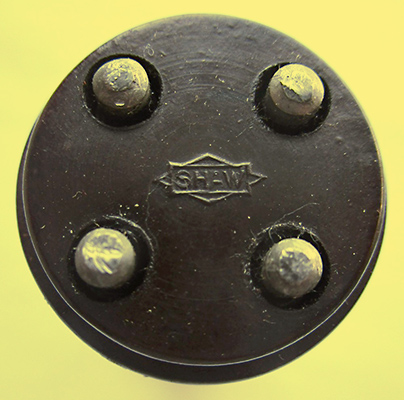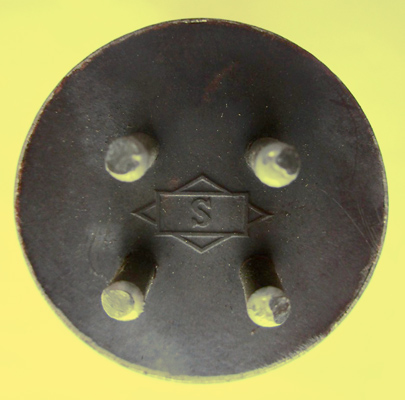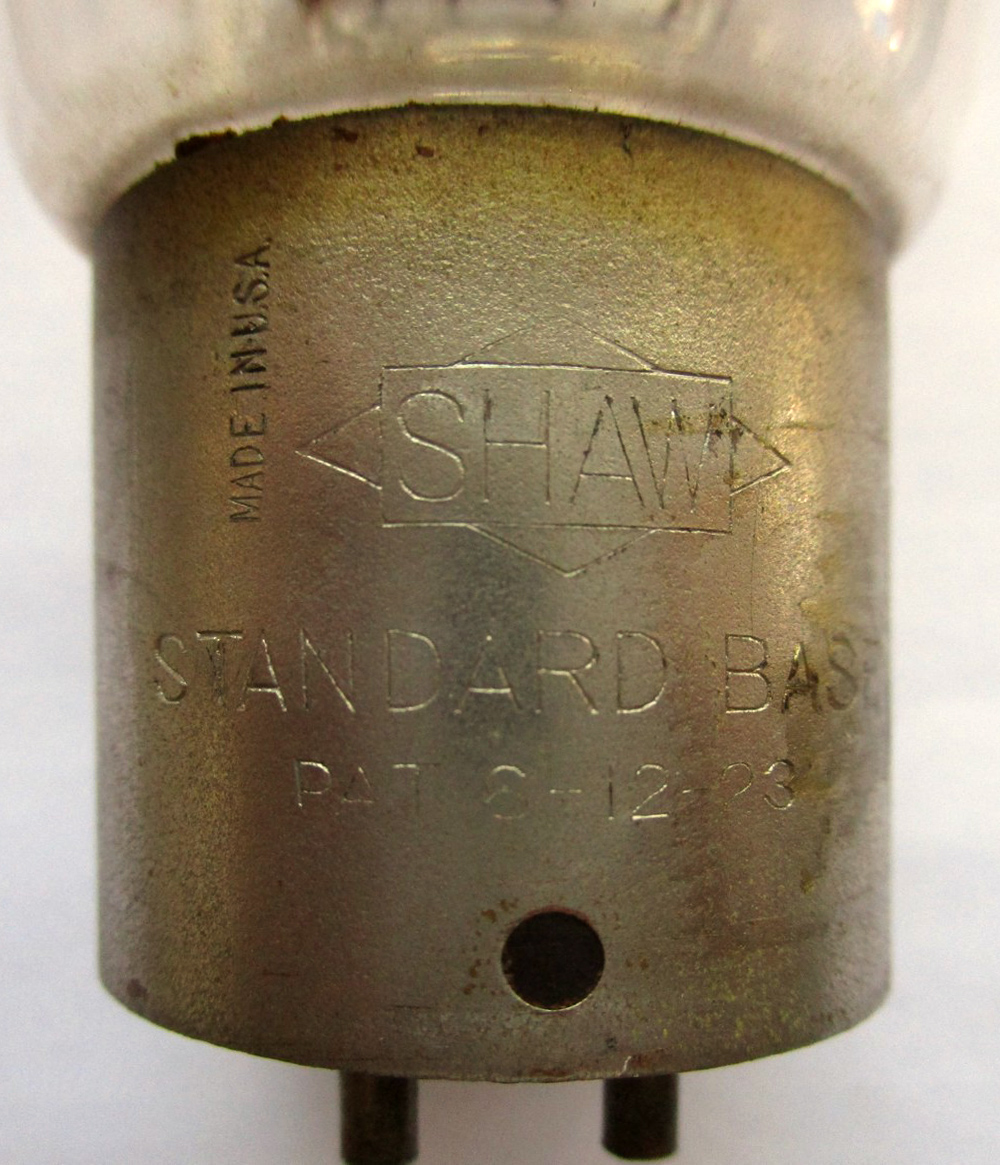|
 
The Shaw logo.
From as early as 1918 the General Electric Company in the US was using radio tube bases made by the Shaw Insulator Company. on a range tubes for the US military. These tubes were the VT-11, VT-12, VT-14, VT-16, CA, TB1, CG886, CG890 and CG1162. This tube base became known as the 'Shaw Standard Base' and has been referred to in some printed material as the 'Navy' base.
It is a UV type and consisted of a brass shell with a moulded insulating disk at the bottom to hold the pins in place. There were four holes in the bottom of the brass shell which allowed the moulding to be held in a non movable position. The base measures 35 mm diameter and 45 mm long, including the pins. The type U Pliotron (also VT-18 and CG-1144) of General Electric made in 1918 used a larger Shaw base, 52 mm diameter. This later became the 'Jumbo 4 pin'. with The exact date has not been confirmed, but later in the same year, use of the bases by General Electric was discontinued when the company started manufacturing their own bases.
Early in 1918 the Shaw Pottery Company of Trenton, New Jersey, expanded with a capital of US$50,000. Incorporators of the company were listed as James Shaw, Jonas Fuld and Enoch Montford., This expansion also enabled the the subsidiary company The Shaw Insulator Company to be formed and the address was 150 Colt St, Irvington New Jersey. The new company made electrical insulators of various kinds. It was controlled by Frank H Shaw and Louis E Shaw.
Frank H Shaw applied for a patent on the 'Standard' radio tube base on August 30, 1919. Patent no 1458153A was granted on June 21, 1923, with Frank H Shaw as inventor and asignee. It is interesting to note that that in the book Saga of the Vacuum Tube by Gerald J Tyne that Shaw is referred to as Henry B Shaw (of the Shaw Insulator Company) on page 174 and Henry S Shaw on page 178. Henry Shaw became president of the Moorhead Laboratories, as announced in the June 1920 issue of the Pacific Radio News, pages 387-389. The article is titled The Reorganization of Moorhead Laboratories and Lee de Forest was also associated with the company.
Late in 1920, the Radio Corporation of America became involved, stating that the tubes made by the company were not licensed under the de Forest and Marconi patents (owned by RCA). Because of the large quantity of raw materials that were on hand, RCA granted a license to Moorhead to manufacture a quota of tubes and this came into effect in July 1921. Henry (S ?) Shaw was listed as chairman of the stockholders/creditors committee.
In the years from the beginning and up to 1923, tubes were made with the 'standard' base on about 15 different tubes made by the company. Known tubes are the de Forest-Marconi ER, and VT, Moorhead A, B, C, A-P (Atlantic Pacific) transmitting and rectifying tubes, A-P, Solenoid tube, de Forest Oscillion, rectifier and VT-20 tubes. The company also made the European B4 base for the Moorhead R and VT-32 tubes. Other American made, but non Moorhead tubes have been seen which have the Standard base.
In 1924, the Shaw Standard base was changed to a dark brown Bakelite design and the UV199 type base was also made. Both these bases had a stylized S within a diamond as a logo. The name 'Shaw' has been seen in the diamond on two 199 style tubes. The logo is on the bottom of the base, surrounded by the pins. Later, apparently in 1925, the company began making black Bakelite UX style bases and in addition to the 'S' logo, the words Made in USA in very small letters is stamped on the base, above the plate(anode) and grid pins.
Shaw tube bases were exported to the UK and Australia, to be used on some valves made there.

Early POVT25 base cap.
In the UK, the Marconi Osram Valve Company used the standard base on the early version of the VT25_GPO (British Post Office) tube. This base is stamped SHAW (within a horizontal diamond) Standard Base Pat. 12-6-23. On later versions of the VT25 and other GPO tubes - VT37, VT37B, VT39 ad VT40, an unbranded polished nickel plated brass base was used. There was no logo on these bases and these later five tubes were made in the early 1930's. The same base is used on a version of the MOV HL2 tube as well as the H.8 tube. One obscure tube also to use this later base is the British Made BTH LJ4, which is equivalent to the UV201A.The brown Bakelite Shaw UV base is used in the mid 1920's on the MOV tubes DE4, DE5, DE5A and DE5B. A DE3 tube (UV199 equivalent) exists in the Queensland Museum in Brisbane (Australia) with the brown Shaw Bakelite UV199 style base. An Osram DE5B tube exists with a black Bakelite UX base. The Australian company Amalgamated Wireless Australasia Ltd (AWA) made the 99 (UV199) with three different bases and one of these was the Shaw base, the same as the MOV DE3. These bases were used for a short time until AWA had 'tooled up' to make their own bases.
With the earlier MOV tubes, it is assumed that as MOV-GEC had not reached a stage of manufacturing their own US style bases, that they had an import arrangement with the Shaw company. The same situation would have applied with AWA.
The tube type numbers mentioned in this article can be found in the Museums' data base. There would be other tubes with the various Shaw bases, details of which are not readily available.
In the above article and references, four Shaw's are mentioned (James Shaw. Frank H Shaw, Louis B Shaw and Henry S Shaw). Information has not been found so far to establish the relationship of each of these, or even that the references themselves are accurate.
According to reference 5, the company was still active as recently as 1950 but no longer making tube bases.
References
- Brick and Clay Record - trade journal, Chicago Vol 52, No 6 March 12, 1918.
- New Castle News, New Castle Pennsylvania, page 5, column 4, May 8, 1920.
- Saga of the Vacuum Tube by Gerald J Tyne, pages 174 and 178.
- Pacific Radio News June 1920, pages 387, 389 and 405.
- Biographical history, J Harry DuBois, plastics expert and employee of The Shaw Insulator Company from 1927 to 1950, Syracuse (New York) University Library.
|